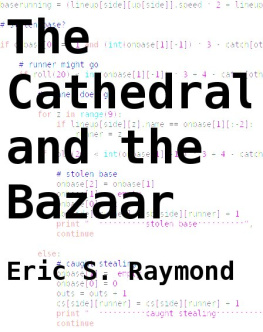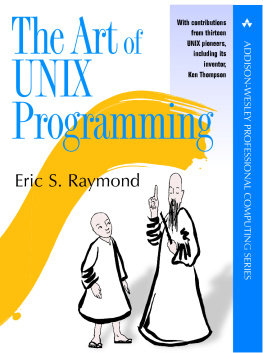Eric S. Raymond - Cathedral and the Bazaar
Here you can read online Eric S. Raymond - Cathedral and the Bazaar full text of the book (entire story) in english for free. Download pdf and epub, get meaning, cover and reviews about this ebook. year: 2010, publisher: Snowball Publishing, genre: Romance novel. Description of the work, (preface) as well as reviews are available. Best literature library LitArk.com created for fans of good reading and offers a wide selection of genres:
Romance novel
Science fiction
Adventure
Detective
Science
History
Home and family
Prose
Art
Politics
Computer
Non-fiction
Religion
Business
Children
Humor
Choose a favorite category and find really read worthwhile books. Enjoy immersion in the world of imagination, feel the emotions of the characters or learn something new for yourself, make an fascinating discovery.
- Book:Cathedral and the Bazaar
- Author:
- Publisher:Snowball Publishing
- Genre:
- Year:2010
- Rating:5 / 5
- Favourites:Add to favourites
- Your mark:
Cathedral and the Bazaar: summary, description and annotation
We offer to read an annotation, description, summary or preface (depends on what the author of the book "Cathedral and the Bazaar" wrote himself). If you haven't found the necessary information about the book — write in the comments, we will try to find it.
This is how we did it. --Linus Torvalds, creator of the Linux kernel
It all started with a series of odd statistics. The leading challenger to Microsofts stranglehold on the computer industry is an operating system called Linux, the product of thousands of volunteer programmers who collaborate over the Internet. The software behind a majority of all the worlds web sites doesnt come from a big company either, but from a loosely coordinated group of volunteer programmers called the Apache Group. The Internet itself, and much of its core software, was developed through a process of networked collaboration.
The key to these stunning successes is a movement that has come to be called open source, because it depends on the ability of programmers to freely share their program source code so that others can improve it. In 1997, Eric S. Raymond outlined the core principles of this movement in a manifesto called The Cathedral and the Bazaar, which was published and freely redistributed over the Internet.
Mr. Raymonds thinking electrified the computer industry. He argues that the development of the Linux operating system by a loose confederation of thousands of programmers--without central project management or control--turns on its head everything we thought we knew about software project management. Internet-enabled collaboration and free information sharing, not monopolistic control, is the key to innovation and product quality.
This idea was interesting to more than programmers and software project leaders. It suggested a whole new way of doing business, and the possibility of unprecedented shifts in the power structures of the computer industry.
The rush to capitalize on the idea of open source started with Netscapes decision to release its flagship Netscape Navigator product under open source licensing terms in early 1998. Before long, Fortune 500 companies like Intel, IBM, and Oracle were joining the party. By August 1999, when the leading Linux distributor, Red Hat Software, made its hugely successful public stock offering, it had become clear that open source was the next big thing in the computer industry.
This revolutionary book starts out with A Brief History of Hackerdom--the historical roots of the open-source movement--and details the events that led to the recognition of the power of open source. It contains the full text of The Cathedral & the Bazaar, updated and expanded for this book, plus Mr. Raymonds other key essays on the social and economic dynamics of open source software development.
Open source is the competitive advantage in the Internet Age. The Cathedral & the Bazaar is a must for anyone who cares about the computer industry or the dynamics of the information economy. Already, billions of dollars have been made and lost based on the ideas in this book. Its conclusions will be studied, debated, and implemented for years to come.
Eric S. Raymond: author's other books
Who wrote Cathedral and the Bazaar? Find out the surname, the name of the author of the book and a list of all author's works by series.








